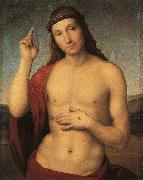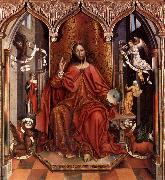Wholesale Oil Painting No Minimum |
|||||||||||
|
|
|||||||||||

|
|||||||||||
|
|
|
||||||||
RaphaelItalian High Renaissance Painter, 1483-1520 Raphael Sanzio, usually known by his first name alone (in Italian Raffaello) (April 6 or March 28, 1483 ?C April 6, 1520), was an Italian painter and architect of the High Renaissance, celebrated for the perfection and grace of his paintings and drawings. Together with Michelangelo and Leonardo da Vinci, he forms the traditional trinity of great masters of that period. Raphael was enormously productive, running an unusually large workshop, and, despite his early death at thirty-seven, a large body of his work remains, especially in the Vatican, whose frescoed Raphael Rooms were the central, and the largest, work of his career, although unfinished at his death. After his early years in Rome, much of his work was designed by him and executed largely by the workshop from his drawings, with considerable loss of quality. He was extremely influential in his lifetime, though outside Rome his work was mostly known from his collaborative printmaking. After his death, the influence of his great rival Michelangelo was more widespread until the 18th and 19th centuries, when Raphael's more serene and harmonious qualities were again regarded as the highest models. His career falls naturally into three phases and three styles, first described by Giorgio Vasari: his early years in Umbria, then a period of about four years (from 1504-1508) absorbing the artistic traditions of Florence, followed by his last hectic and triumphant twelve years in Rome, working for two Popes and their close associates. |
||||||||
|
|
||||||||
The Blessing Christ
The Blessing Christ Painting ID:: 3312 |
Pinacoteca Tosio Martinengo, Brescia Pinacoteca Tosio Martinengo, Brescia |
|||||||
|
|
||||||||
Gallego,FernandoFernando Gallego (c. 1440 - 1507) was a Spanish painter, brought up in an age of gothic style, his art is generally regarded as Hispano-Flemish style. It's thought that he was born in Salamanca, Spain, and his first known works were in the cathedrals of Plasencia and Coria, in Ceeres (Spain). His most famous known works are: The Retablo of San Ildefonso, in the Cathedral of Zamora, Spain The Sky of Salamanca, in the University of Salamanca, Spain The Retablo of Ciudad Rodrigo, now at the University of Arizona, Arizona, USA The Arcenillas' panels, placed in Zamora, Spain San Acacio and the 10,000 Martyrs, at the Meadows Museum, Dallas, Texas, USA The last time that he was named in a document is in 1507, but the date of his death is unknown. |
||||||||
|
|
||||||||
|
|
The Blessing Christ
The Blessing Christ Painting ID:: 92553 |
1492
Oil on panel, 169 x 132 cm
TTD 1492 Oil on panel, 169 x 132 cm TTD |
||||||
|
|
||||||||
|
Gallego,Fernando Fernando Gallego (c. 1440 - 1507) was a Spanish painter, brought up in an age of gothic style, his art is generally regarded as Hispano-Flemish style. It's thought that he was born in Salamanca, Spain, and his first known works were in the cathedrals of Plasencia and Coria, in Ceeres (Spain). His most famous known works are: The Retablo of San Ildefonso, in the Cathedral of Zamora, Spain The Sky of Salamanca, in the University of Salamanca, Spain The Retablo of Ciudad Rodrigo, now at the University of Arizona, Arizona, USA The Arcenillas' panels, placed in Zamora, Spain San Acacio and the 10,000 Martyrs, at the Meadows Museum, Dallas, Texas, USA The last time that he was named in a document is in 1507, but the date of his death is unknown. The Blessing Christ 1492 Oil on panel, 169 x 132 cm TTD |
||||||||
|
|
||||||||
|
Prev Next
|
||||||||
|
|
||||||||
|
Related Paintings to Gallego,Fernando :. |
||||||||
|
|
||||||||
|
CONTACT US |


